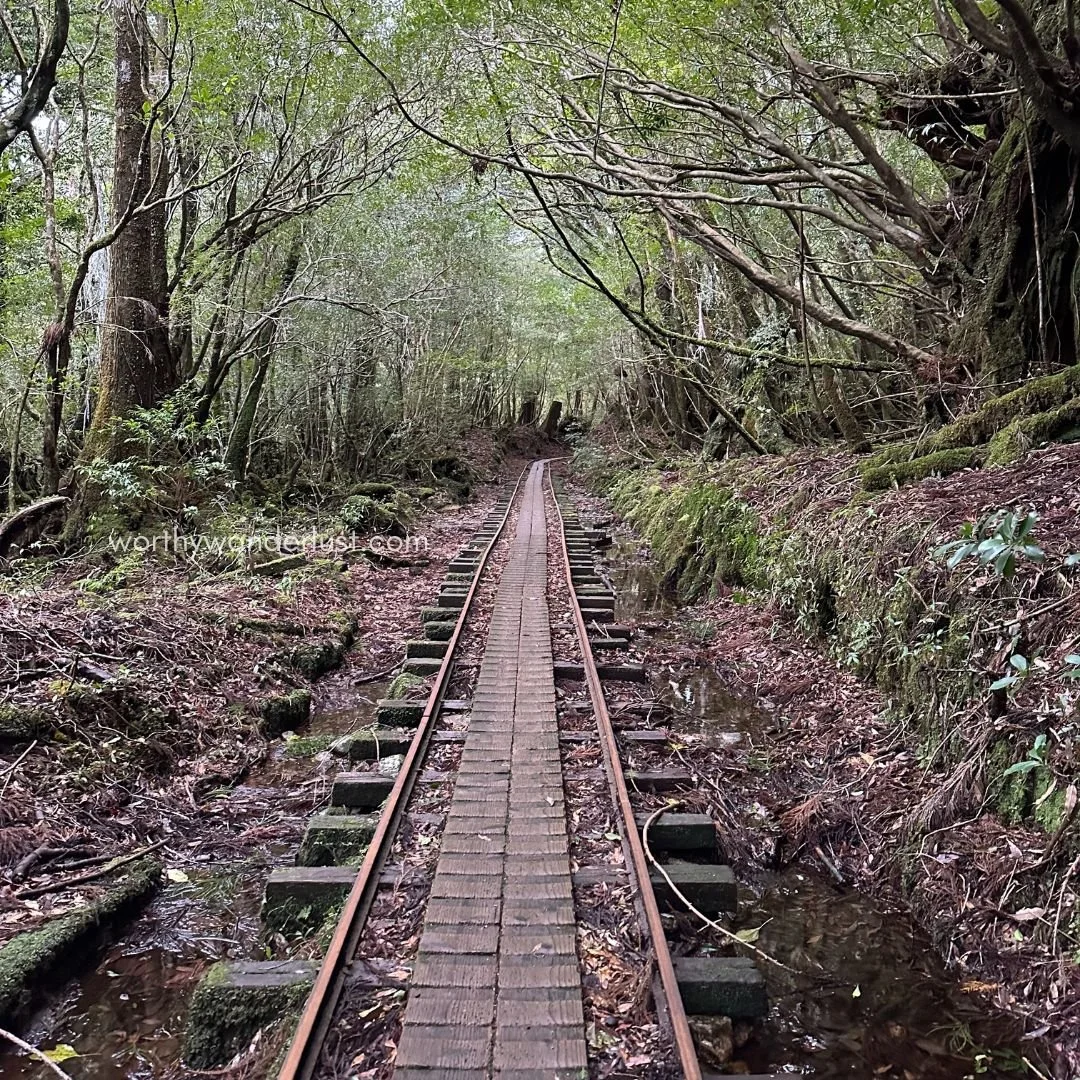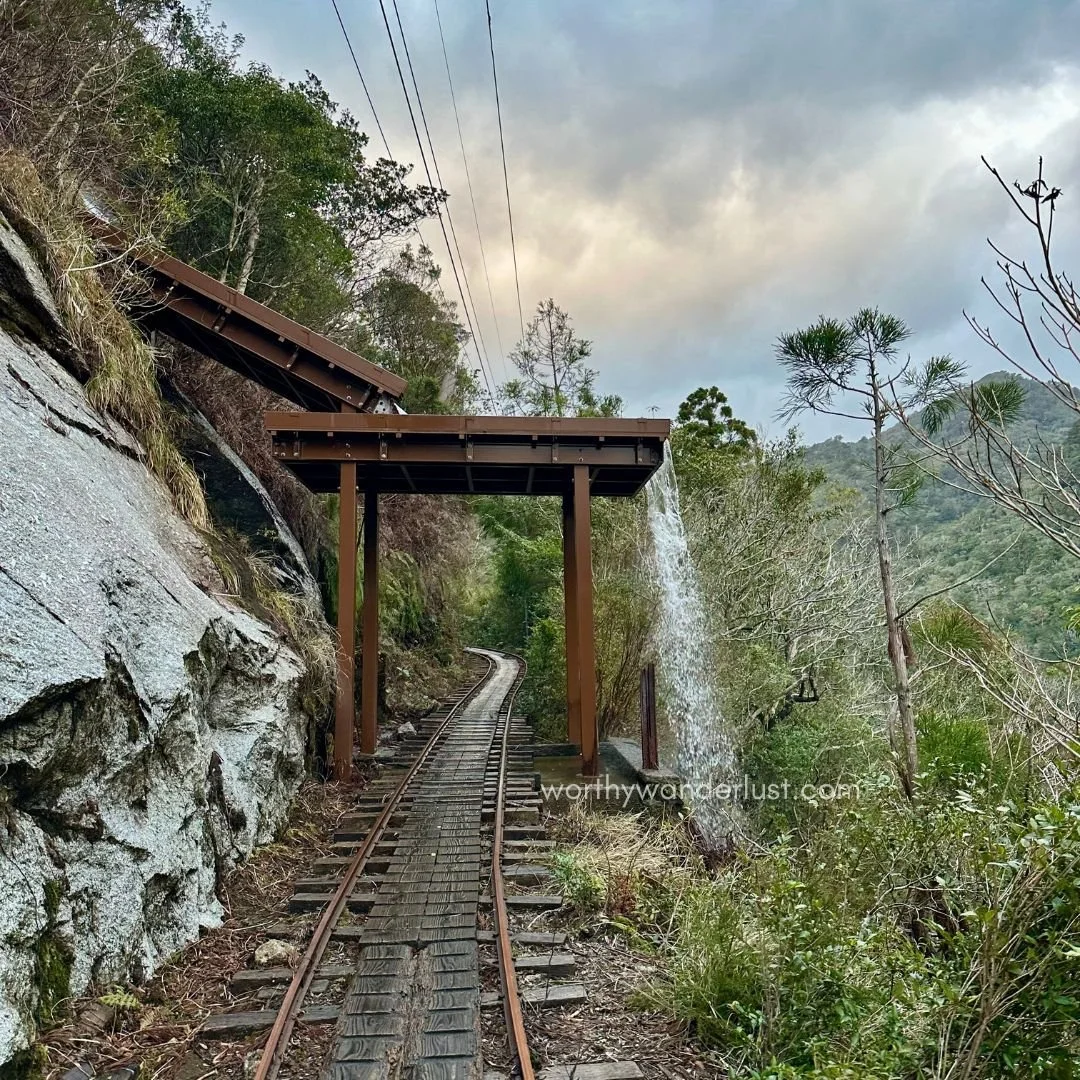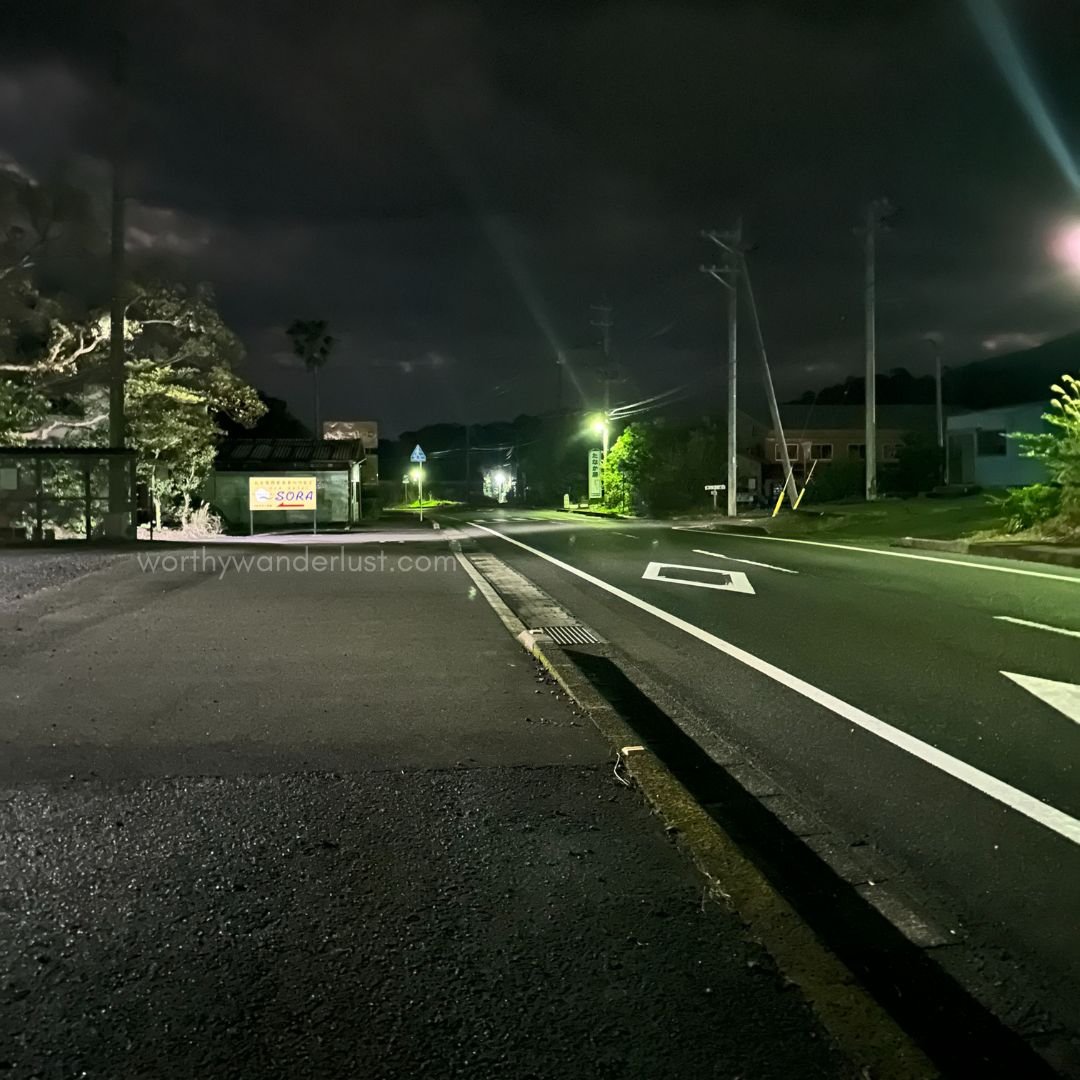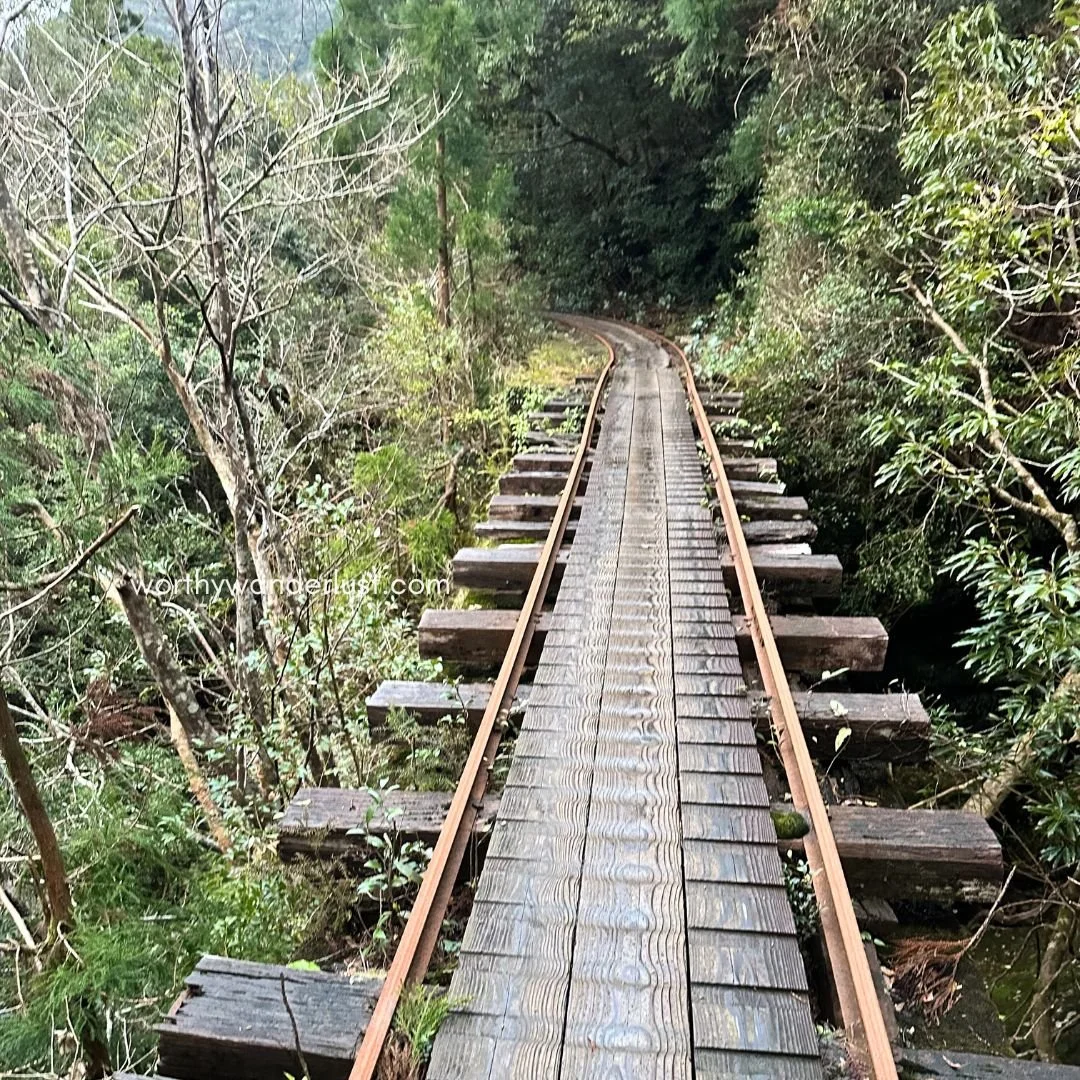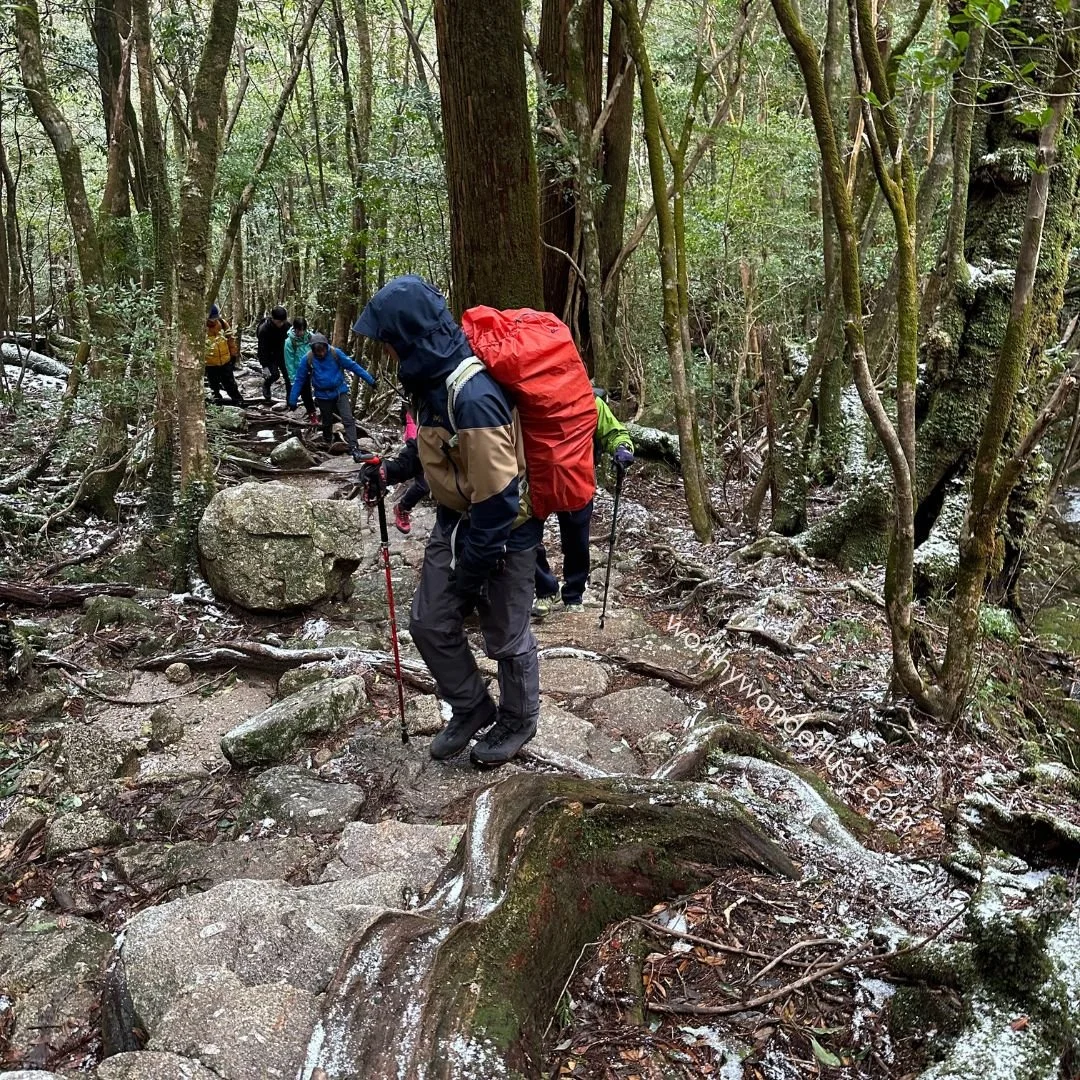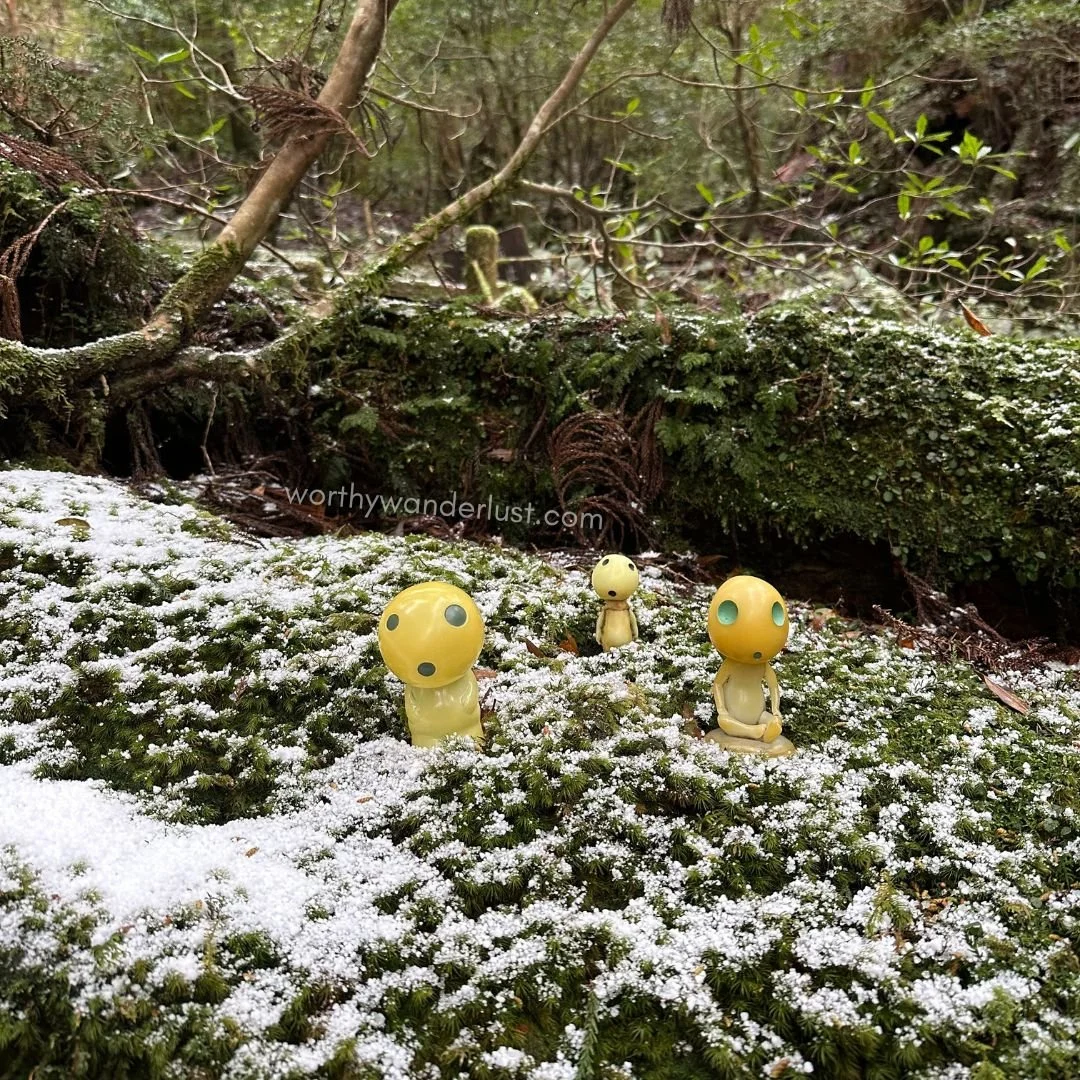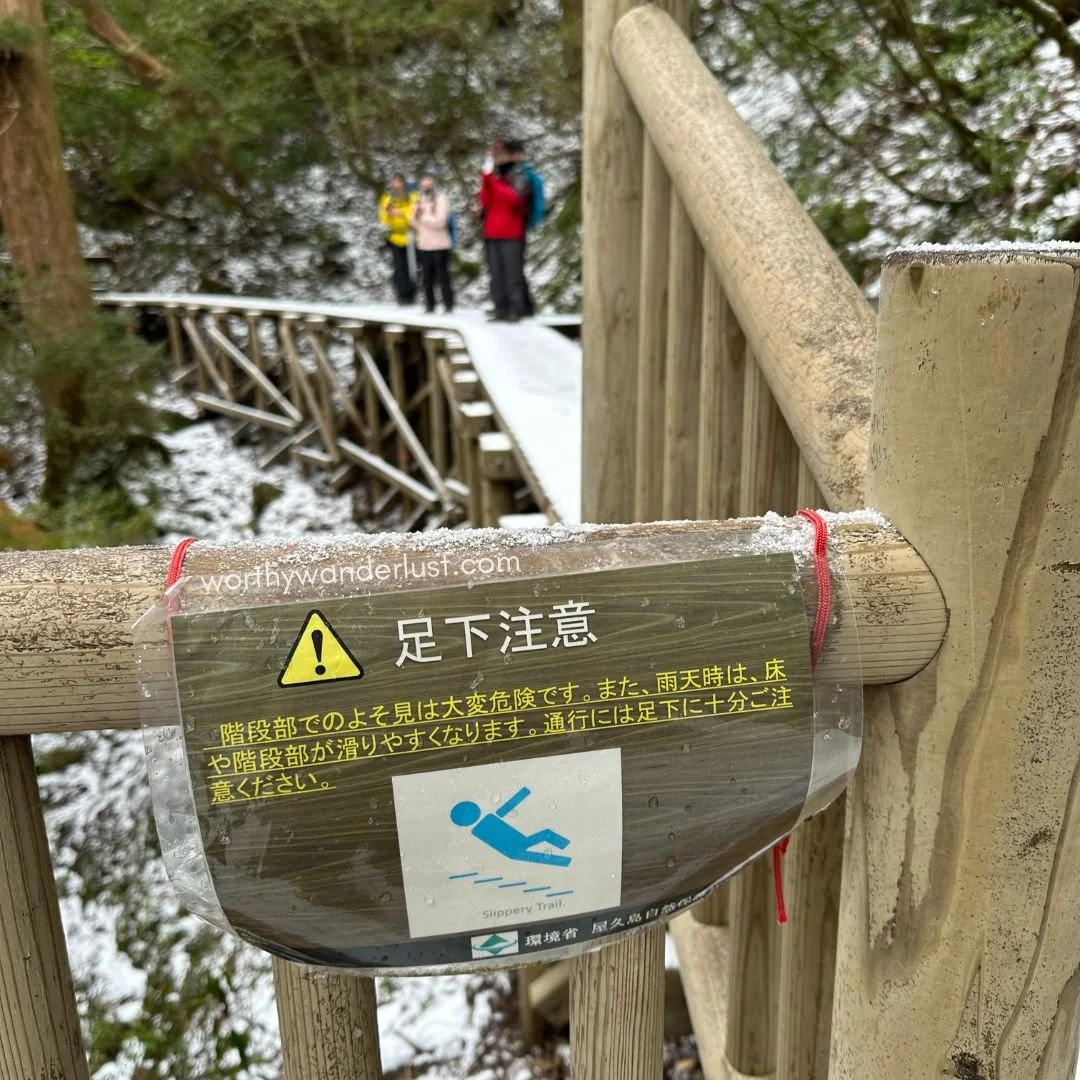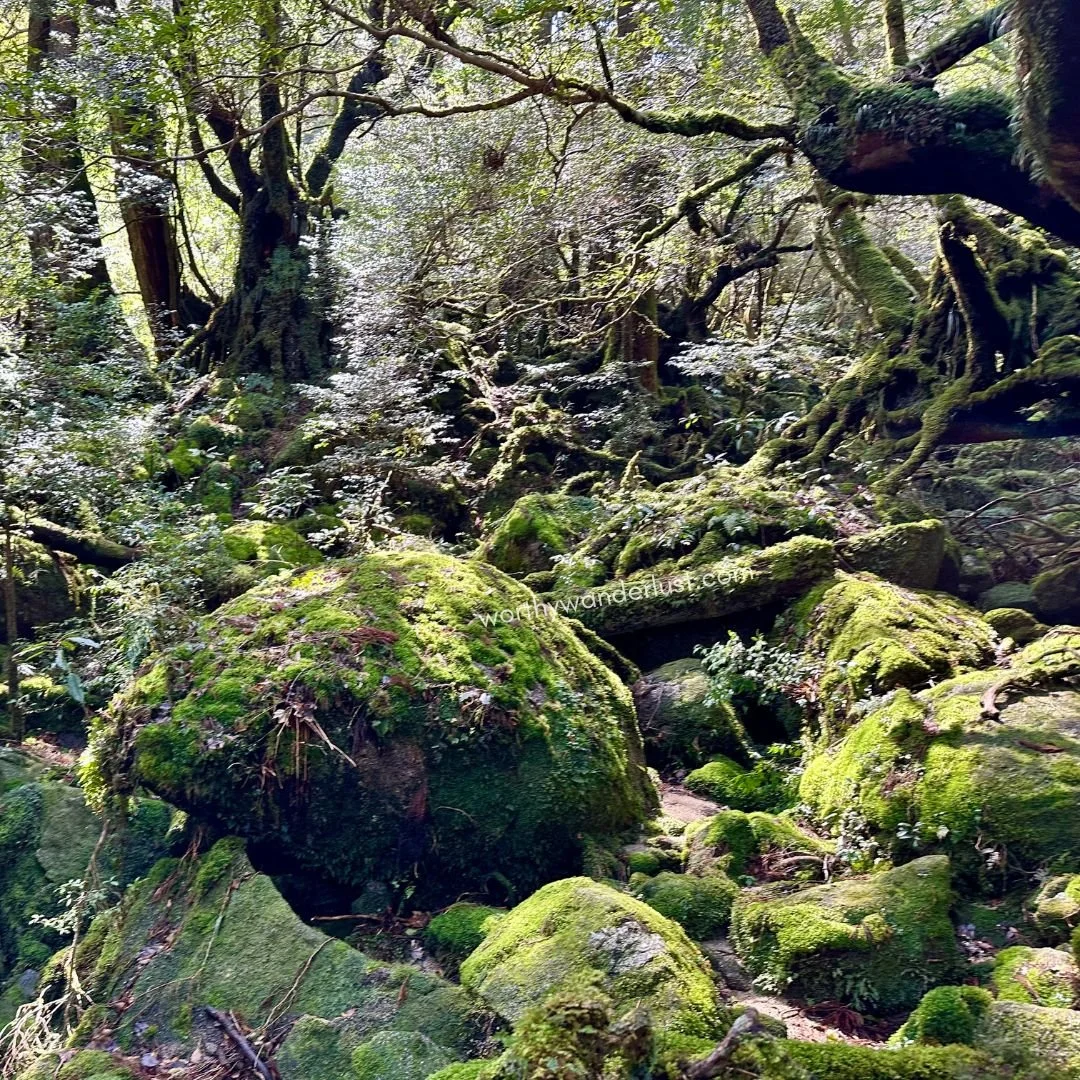Yakushima | Jomon Sugi Hike: A Practical Guide + My Unfiltered Experience
At the heart of Yakushima, a subtropical island off the south coast of Kyushu, Japan, are ancient cedar forests, mystical moss-covered landscapes, and an otherworldly atmosphere that inspired Studio Ghibli's film, Princess Mononoke.
Jomon Sugi (縄文杉), estimated to be over 2,000 years old and regarded as Japan's oldest and largest living cedar tree, stands amid Yakushima’s pristine wilderness. With its massive ~16m trunk circumference, this natural monument is the focal point of the famous Jomon Sugi trail and draws hiking enthusiasts from across the globe (including me!).
My journey through the primeval forest wasn't without challenges—an unfortunate pre-dawn tumble, precarious bridges, and daunting staircases tested my resilience. Yet, encountering nature’s remarkable feats made the adventure memorable, if not entirely as I expected.
One thing’s for sure: I felt very alive by day’s end. Cue the celebratory sushi and shochu!
Read on for my practical hike guide and personal trail report, with WoWa Tips scattered throughout to help you plan your own adventure.
Also, don't miss my honest thoughts at the end on whether the Jomon Sugi hike is truly worth the journey!
This post is not sponsored & reflects my personal opinions.
Planning your Jomon Sugi Adventure
Finding current and reliable information for your Jomon Sugi adventure can be challenging due to the language barrier. My top tip? Use your browser’s translation feature on official Japanese websites—they usually have the most current details, whereas their English pages may contain outdated information.
I’ve also encountered conflicting information across multiple sources, so I’ve done the hard work for you and shared the most useful and current information I’ve found (as of May 2025) here!
Getting to and around Yakushima
The Yakushima Tourism Association offers comprehensive information, including:
When it comes to reaching Yakushima, home to a UNESCO World Heritage-listed forest area, there are trade-offs between air and sea travel (as detailed on Yakushima Tourism Association’s webpage). Once on the island, however, renting a car is undoubtedly the best way to explore since attractions are far apart and public transport options are limited.
The airplane I took from Fukuoka to Yakushima was probably the smallest plane I’ve ever been on. Glad I made it!
WoWa Tips
Don’t drive or prefer not to? Fret not! Public buses connect the airport, ferry terminals, and most popular attractions; I relied entirely on them during my trip and managed fine, even with heavy luggage.
Planning ahead is crucial if you’re relying on public buses—they run infrequently during the day and don’t operate at night. Unless you take a taxi, that means:
Carefully organising your activities to match bus times.
Choosing to have dinner at your accommodation or nearby spots.
Check current timetables and bus routes and consider a multi-day bus pass—I found the 3-day pass good value and convenient (no digging for spare change needed).
On board a public bus in Yakushima.
Essential Trail Info & Resources
Length: ~22 km (8 to 10 hours) return.
Difficulty: Rated 4/5 by Yakushima Tourism Association.
Terrain: ~16 km on a mostly flat old railway track + ~6 km on forest trails with stairs and uneven terrain.
Getting there: Take a shuttle bus from ‘Yakusugi Shizenkan’ (accessible by public bus) to the trailhead, ‘Arakawa Tozanguchi’, as the road is closed to private vehicles from 1 March to 30 November. Find more information and bus timings here.
Useful resources: What to Wear & Bring | Route Maps & Altitude Graphs | Climbing Etiquette | Climbing Notification | Hand-drawn Map with toilets, notable cedars, and more marked (cute and handy!)
Remnants of an old railway track, now part of the Jomon Sugi Trail.
WoWa Tips
Difficulty level check
Manageable for reasonably fit hikers (I finished in ~8.5 hours in Spring), and potentially challenging for beginner hikers, those with mobility concerns, or anyone uneasy with railless bridges and staircases.
Snow alert
There may be snow at higher elevations, even in Spring or Autumn, it gets extra slippery when melting. I was surprised the local tourist centre didn’t mention this when I asked about the weather the day before!
Perhaps skip the poles
I didn’t find hiking poles very useful on this trail, as most of it is flat railroad or stairs. There were fewer steep or uneven sections where I’d normally use them.
Toilet situation
Clean, comfortable facilities at the starting point; basic squat toilets at railroad end. There’s also a bio toilet and a portable toilet booth along the route (I didn’t use these).
My must-have gear
Microspikes (for snow) | Hiking boots (for better grip) | Rain jacket (for Yakushima’s unpredictable weather) | Gloves (for grabbing support structures) | Standard hiking attire.
No handrails? Time to activate that core!
My Jomon Sugi Hike Report
5 am | A Stumbling Start
My solo adventure in mid-March 2025 began with a moment of panic (which turned out completely unnecessary!), as I rushed to catch the only public bus connecting to the trailhead shuttle bus.
In the darkness, I tripped and tumbled, arriving at the bus stop with bloody hands, scraped limbs, and my iPhone sporting a new green lightsaber-like line across its cracked screen. Not quite the start I’d imagined!
My view from a bus stop in Anbo, Yakushima, where I had a stumbling start to my day.🥹
5:30 am | Plaster Up & Push On
At Yakusugi Shizenkan, I swallowed my embarrassment and asked the ticket vendor for plasters using Google Translate.
As sleepy hikers around me sat quietly on the shuttle bus, I bit back tears as I sanitised my scrapes and applied plasters—the hike must go on! 💪🏻
Waiting area for the shuttle bus from Yakusugi Shizenkan (Yakusugi Nature Museum) to Arakawa Tozenguchi (Arakawa Trailhead).
6:35 am | Revved Up & Ready
Finding Japan's signature high-tech toilets (heated seats and all) at the remote Arakawa Trailhead was an unexpected delight.
With my warm gear on and spirits lifted, I set off with renewed determination.
The amazingly clean and comfortable washroom at the starting point. There’s also an indoor resting area beside it.
About to start the hike but first, a selfie.🤳
6:45 am | Cross if You Dare
The seemingly innocuous railway track quickly revealed its first challenge—a narrow bridge without guardrails, suspended several meters above ground. Terrified yet determined, I knew there was no turning back!
Am I on a hike, or an adventure reality show?🤔
7:30 am | Mind the Gaps
Up ahead, another bridge lay in wait. While this one had protective side barriers, there were treacherous gaps between wooden planks.. Never a dull moment in this hike, it seems.
I wouldn’t want to miss a step on this bridge.
7:45 am | Forest Wonder
My morning mishap soon faded away as I wandered through a mystical scene of thin, towering trees, passed a family of monkeys, and admired moss-covered stumps and other forest curiosities.
The pillar-like trees created an immersive woodland sanctuary that left me spellbound.✨
9 am | The Hiking Gets Real
After a much-needed toilet trip (no heated seats this time, but I can't complain) and a quick snack break, the proper wilderness hiking began.
The vegetation grew noticeably lusher as I gained elevation, signalling Mount Miyanoura’s changing ecosystem.
Fellow hikers along the trail. Although there were occasional larger groups, I never found the trail crowded.
9:25 am | The Heart of Wilson’s Stump
Have you ever had one of those moments when nature takes your breath away? That’s how I felt exploring Wilson's Stump, the hollowed-out remains of a once towering cedar tree, which has a small shrine tucked inside.
Noticing my puzzled glance as fellow hikers looked skyward, a friendly local guide kindly showed me how to capture the stump’s striking heart-shaped opening—a natural wonder!
Just add a double door, and it’s a hobbit’s home.
A heart-shaped wonder of nature. 💚
9:30 am | Spot the Kodomas
As I left Wilson’s Stump, a fellow hiker called out ‘One-san!’ (literally ‘big sister’, and also used like ‘Miss’) to me and happily pointed out a group of adorable Kodoma—little tree spirits from the Princess Mononoke film—hiding in a shrub.
Kodama sightings! Some hikers bring Kodama figurines—big and small—for fun photo ops.
9:35 am | Snow & Steady
With just 2 km to go, I tackled a series of snow-sprinkled staircases without railings, focusing on one careful step at a time and feeling very grateful for my microspikes.
It's leg day, baby!
Looking back at how far I’ve climbed.
I felt comforted by the pink ribbons marking the route of the Jomon Sugi hike.
10:25 am | Cedar of the Great King
Arriving before Daiosugi (大王杉), a 23.7m tall cedar estimated to be over 3,000 years old, I stood in awe of this majestic giant that has witnessed centuries of changing seasons.
Mysteriously, it appears to be guarded by slender, copper-coloured trees.
Every King needs his guards.
Danger lurks nearby. Thankfully I made it past this narrow platform without falling!
11 am | Hello Jomon Sugi
Finally reaching Jomon Sugi, I felt surprised to find both viewing platforms rather far from the massive 25.3m tree. To be honest, the experience felt somewhat underwhelming compared to my up-close encounter with Daiosugi.
Still, I couldn't help marvelling at this forest elder and its mini-ecosystem of plants growing right on its trunk. Nature is truly remarkable.🫶🏻
Finally face to face with Mr Jomon Sugi.
12 pm | A Slippery Situation
The return journey definitely kept me on my toes—the descent down railless, snow-sprinkled staircases took full concentration and, as the day warmed up, even flat surfaces became dangerously slippery from the melting snow.
Despite my cautious pace, I tumbled twice and had several close calls. The one thought on my mind? Get back in one piece.🙏🏻
Planning to hike the trail in colder months? Pack balance and bravery!
2:50 pm | Home Stretch Triumph
When the tunnel came into view, relief washed over me. I had reached the final stretch, arriving just in time for the first return bus—tired and a little battered, yet quietly triumphant to have conquered the Jomon Sugi trail despite my fears and challenges.
Dramatic as it sounds, I was deeply thankful to have made it alive and in one piece! 🥲
The tunnel is a sign that the end is near. No finish-line selfie this time—I must have been totally spent!
WoWa Tips
Anbo vs Miyanoura
Tackling the Jomon Sugi Hike? Stay in Anbo rather than Miyanoura (the island’s two main towns). It’s closer to the trailhead, which means more precious sleep before an early start.
Value-Packed Gem for Solo Travellers
Despite the limited dinner options nearby, I simply couldn’t find a better deal—Yakushima Green Hotel offers reasonably priced single rooms with ensuites (I paid ~¥10,000 a night), offers, is located near a bus stop, and has bonus amenities like an onsen and a massage chair—perfect for post-hike fatigue.
Post-Hike Comfort Food
Its proximity to my hotel is why I first had dinner at Iso no Kaori, but its warm service, delicious food, and cozy ambience were what made me return. Don’t miss their soul-warming miso soup, addictive fried sweet potato, satisfying sushi, and local specialities like tankan juice and shochu.
Supermarket Shopping
While there isn’t a typical konbini (convenience store) in Anbo, Banchan (~20 mins’ walk from Yakushima Green Hotel) carries a solid selection of fruit, snacks, basic essentials, and more.
My clean and comfy single room at Yakushima Green Hotel.
Post-hike celebratory sushi set at Iso no Kaori.
My Honest Review—Is the Jomon Sugi Hike Worth the Journey?
There are incredible wonders of nature along the Jomon Sugi Trail, and there’s undeniable satisfaction in conquering this famous hike.
Truth be told though—unless seeing Japan’s largest and oldest cedar is on your wishlist, I’d personally recommend prioritising the Taikoiwa (Taiko Rock) hike in Shiratani Unsuikyo over the Jomon Sugi hike.
Here's why:
A more enjoyable hiking experience: The mostly flat railroad portion of the Jomon Sugi trail can become repetitive, whereas the Taikoiwa course offers more varied trail terrain and gorgeous forest paths.
Prime moss magic: If you're dreaming of Yakushima's iconic moss wonderland that inspired Princess Mononoke, ‘Kokemusumori’ (Moss-Covered Forest) along the Taikoiwa course invokes a more immersive and enchanting atmosphere than the occasional mossy corners by the Jomon Sugi Trail.
Ancient cedars with less time commitment: Several magnificent, old-growth cedars line the Taikoiwa course too, offering similar awe-inspiring encounters without an 8-10 hour trek or pre-dawn departure (I completed the Taikoiwa course in ~4 hours).
Gentler for the heart: The Taikoiwa course has a few river crossings and steep inclines, but none of the rail-less bridges or staircases that make parts of the Jomon Sugi trail potentially anxiety-inducing.
All that said…if you have the time and energy for both, why not do both?
Check out @worthy.wanderlust for pics and more on my Taikoiwa adventure!
A lovely moss-covered corner along the railway section of the Jomon Sugi Trail,
Photos don’t do justice do the enchantingly beautiful 苔むす森 (Moss-Covered Forest).
Thank you for dropping by!
Thanks for dropping by my website! Your support means a lot and encourages me to keep creating and sharing helpful content. Discover more value-packed Japan adventures on my blog or @worthy.wanderlust.
